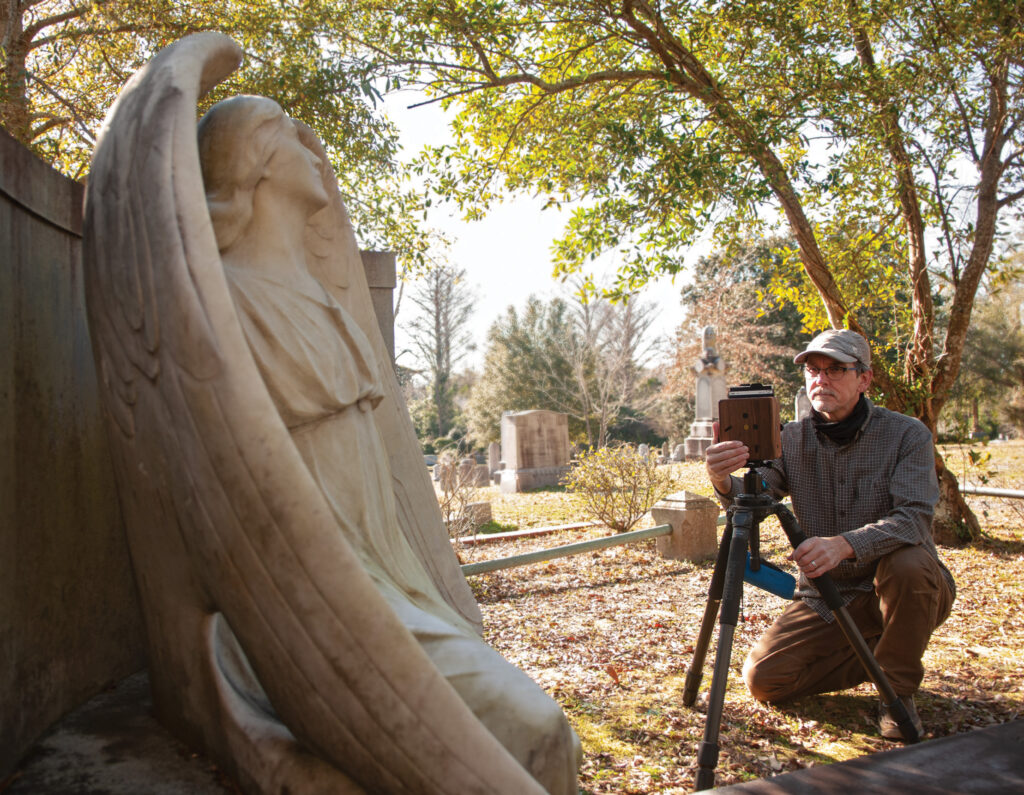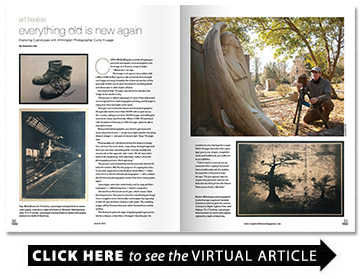Everything Old is New Again
Exploring cyanotypes with Wilmington photographer Curtis Krueger
BY Amanda Lisk

Curtis Krueger grabs a bottle of hydrogen peroxide and applies several droplets onto his image as it floats in a tray of water.
“Watch this,” he says.
The image is of cypress trees, taken with a Nikon D300 at Blue Cypress Lake in Florida from a kayak one foggy morning. Instantly, the chemical reaction of the peroxide trickles out to each tree branch, revealing detail and dimension in dark shades of blue.
“Just look at that,” Krueger marvels as he transfers the image to his studio to dry.
The process is called cyanotype. It’s one of the oldest and most original forms of photographic printing, and Krueger is using it to shed new light on his work.
Krueger is an acclaimed nature and bird photographer. He typically travels more than 30,000 miles a year across the country, taking more than 50,000 images and selling his work at art shows and festivals. When COVID-19 interfered with his planned itinerary in 2020, Krueger opted to take a trip back in time.
“Being a bird photographer, you tend to get more and more expensive lenses — to get more light, quicker focusing, sharper images — and part of me just said, ‘Stop,’” Krueger says.
“Photography isn’t all about having the sharpest image. You can have the most clean, crisp, sharp, boring image and then you can have something that’s moody, muddy and emotional on the opposite side. I said, ‘OK, let’s just start back at the beginning,’ and cyanotype really is, from the photography process, the beginning.”
The process was invented by astronomer and chemist Sir John Herschel in 1842 for the purpose of copying his notes. It was later expanded on by botanist Anna Atkins — often referred to as the first female photographer — who created the first known photographic book of her ferns using cyanotypes. One show that did take place in 2020 was at Art in Bloom Gallery of downtown Wilmington. On a whim, Krueger entered a small collection of his cyanotype images. To his surprise, several sold before the show even opened.
“His technique is just fantastic, and I’ve noticed other people have a strong response to his work too, taking all his experience, not only with technique but with life and that comes through with his art,” says Amy N. Grant, Art in Bloom Gallery owner.
When not on the road, Krueger begins his days in Wilmington at Burnt Mill Creek, where there has been a family of owls.
“I’d wake up every morning to get down there at first light. I got there one morning and I saw the babies. I set my tripod down and I thought, ‘Where’s the mom?’ I turned around and she was on my tripod,” he laughs. “And, my cameras were underneath my tripod, so I got my phone and took her picture, and it was just such a magical experience.”
That photograph of the mama owl printed using the cyanotype process recently sold at Art in Bloom Gallery.
“Never stop learning, never stop trying something new,” Krueger says.
Even if it’s something old.
Cyanotypes were also extensively used to copy architectural plans — called blueprints — before computers.
Derived from the Greek word cyan, which means “dark blue impression,” the process involves transferring an image from a negative onto chemically coated paper by exposing it with UV rays and then rinsing it with water. The resulting image will be Prussian blue and white if printed on a white surface.
The final and optional stage of applying hydrogen peroxide for a deeper, richer blue is Krueger’s favorite part. He sometimes uses tea bags for a sepia finish. Krueger describes the cyanotype process as simple, straightforward, and traditional, yet endless in its possibilities.
“I don’t want to come across as someone who’s saying I’ve turned into a traditionalist all of a sudden because this is the purest way,” he says. “I’m just saying I want to respect the past and I want to use that and also bring it into the future. There are no limits, I like that.”
